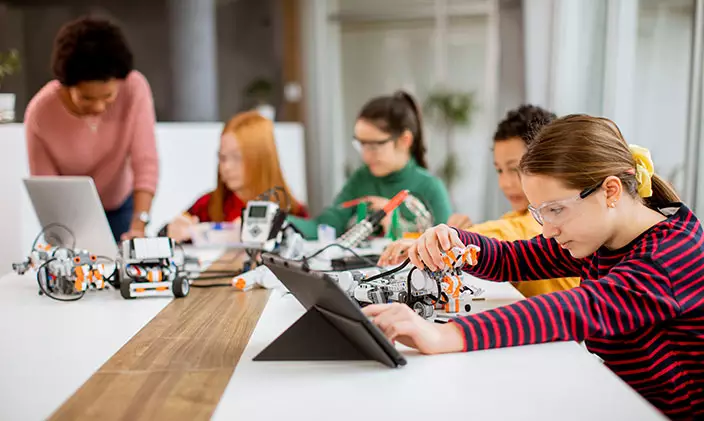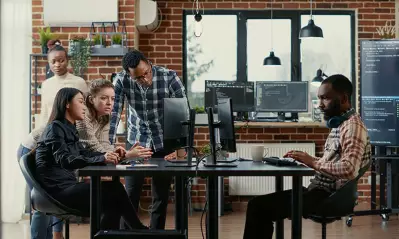How coding can boost kidsŌĆÖ emotional intelligence

Written by Elizabeth Exline

Reviewed by┬ĀKathryn Uhles, MIS, MSP,┬ĀDean, College of Business and IT

ŌĆ£I am an educator,ŌĆØ says Deby Ranft, EdD/ET. ŌĆ£And I think that emotional intelligence of children is probably on all educatorsŌĆÖ radar.ŌĆØ
Ranft, who teaches sixth grade and an online masterŌĆÖs-level tech course, may be right, but her approach to understanding emotional intelligence in children took a turn for the esoteric when she began to view it through a lens of technology.
This happened while she was pursuing her┬Ādoctoral degree in education┬Āat SMĄ„Į╠╦∙.
ŌĆ£I decided on the program of Educational Leadership with a specialization in Educational Technology, because I knew that technology was the future of the educational field,ŌĆØ Ranft explains. ŌĆ£At my first residency, I met three other students who changed the trajectory of my life. ŌĆ” [We] created a group project called ŌĆśGot Tech?ŌĆÖ that we presented to the class, and it has eventually morphed into what we now call┬Ā.ŌĆØ
What is a hackathon?
For the non-coders of the world, a┬Ā┬Ābrings together a group of computer programmers to┬Ādevelop a software solution┬Āfor a specific need. ItŌĆÖs social coding at its finest, in other words, and itŌĆÖs usually time sensitive: Most hackathons wrap after 24 or 48 hours.
ThatŌĆÖs all well and good for career programmers, but how does it apply to kids? For Ranft, itŌĆÖs personal. ŌĆ£My youngest son got involved in the LEGO robotics program when he was in fifth grade,ŌĆØ she says. ŌĆ£I saw how┬Āengaged the students┬Āwere while working to code their robots and participating in creative competitions.ŌĆØ

This informed RanftŌĆÖs decision to pursue the doctoral degree program she chose, and it also laid the groundwork for Hackathon Jr. RanftŌĆÖs sonŌĆÖs experience proved there was a market for┬Ākid-centered hackathon experiences. Ranft and her colleagues, including┬Āserial entrepreneur Rose Lorenzo, PhD, just needed to figure out what that would look like.
And Hackathon Jr. is ŌĆ”
Over time, Hackathon Jr. morphed into a more focused and condensed version of a traditional hackathon. Instead of one or two days, they last┬Āeight hours. Instead of catering to career programmers or adults in general, they welcome┬Āchildren ages 9 to 13┬Āwho may have┬Ānone, some or lots of programming experience.
The most important way in which traditional hackathons and Hackathon Jr. are similar, however, is in their goal ŌĆö and the potential roadblocks to meeting it. In Hackathon Jr., children are tasked with┬Āusing technology to solve a real-world problem. They work in teams to identify a problem, design a solution, draft a prototype and pitch it to the judges, all within what is a typical workday period for most adults.
ŌĆ£These kids sometimes show up┬Āunwilling to collaborate┬Āwith a group or┬Āunsure of how to communicate┬Āwith each other,ŌĆØ Ranft observes. ŌĆ£However, in traditional hackathons sponsored by companies, these are the skills recruiters are looking for most! This has led us to really focus on encouraging those skills at our events.ŌĆØ
The gold behind the code
Lorenzo likens Hackathon Jr.ŌĆÖs lessons on┬Āleadership and collaboration┬Āto sneaking vegetables into cookies. Kids like technology and solving problems. ThatŌĆÖs the fun part. Working together and communicating ideas, those are the ŌĆ£veggiesŌĆØ they swallow alongside the thrill of tech.
ŌĆ£Coding is not really what we do,ŌĆØ Lorenzo says. ŌĆ£ItŌĆÖs the platform that we use.ŌĆØ
As Ranft outlines in her dissertation, ŌĆ£,ŌĆØ the three overarching themes of computational thinking at Hackathon Jr. events are:
- Collaboration
- Programming┬Āchoices that lead to a digital solution
- Communication
While creating a digital solution is a valuable hard skill for tech careers, collaboration and communication can be just as important.
ŌĆ£Computational thinking at hackathons and emotional intelligence are directly tied to each other,ŌĆØ Ranft explains. ŌĆ£My research supported the idea of a hackathon being used as an instructional strategy to integrate computer science across any curriculum with kids as young as third grade.ŌĆØ
A prescription for the future?
For Ranft, her doctoral research has directly impacted her day-to-day experience in the classroom. Her instructional methods reflect what sheŌĆÖs learned through Hackathon Jr, whether thatŌĆÖs tasking sixth graders with building a video game about an ancient civilization, teaching graduate students how to use technology purposefully or coaching other educators.
ŌĆ£Often, I think that teachers are hesitant to attempt this sort of approach for younger students, but Hackathon Jr. has shown that younger kids have the best ideas!ŌĆØ Ranft says. ŌĆ£I believe that hackathons could be used as authentic assessments for computer science curriculum.ŌĆØ
They could even be used outside of computer science. ŌĆ£The world needs people who know how to communicate, collaborate, be creative and think critically, but it all begins with emotional intelligence and purposeful technology use,ŌĆØ Ranft says.
This idea of collaboration, communication and ŌĆ£purposeful technologyŌĆØ goes beyond the classroom and the field of tech. In RanftŌĆÖs view, hackathons combine three elements that can change the world.
ŌĆ£Good computer science instruction should encourage students to see the potential in their ideas when shared with the world to make it a better place for everyone.ŌĆØ
Hackathon Jr. might not be a utopia ŌĆö but it can offer a pathway to a version of one.

ABOUT THE AUTHOR
Elizabeth Exline has been telling stories ever since she won a writing contest in third grade. She's covered design and architecture, travel, lifestyle content and a host of other topics for national, regional, local and brand publications. Additionally, she's worked in content development for Marriott International and manuscript development for a variety of authors.

ABOUT THE REVIEWER
Currently Dean of the College of Business and Information Technology,┬ĀKathryn Uhles has served SMĄ„Į╠╦∙ in a variety of roles since 2006. Prior to joining SMĄ„Į╠╦∙, Kathryn taught fifth grade to underprivileged youth in Phoenix.
This article has been vetted by SMĄ„Į╠╦∙'s editorial advisory committee.┬Ā
Read more about our editorial process.
Read more articles like this:


